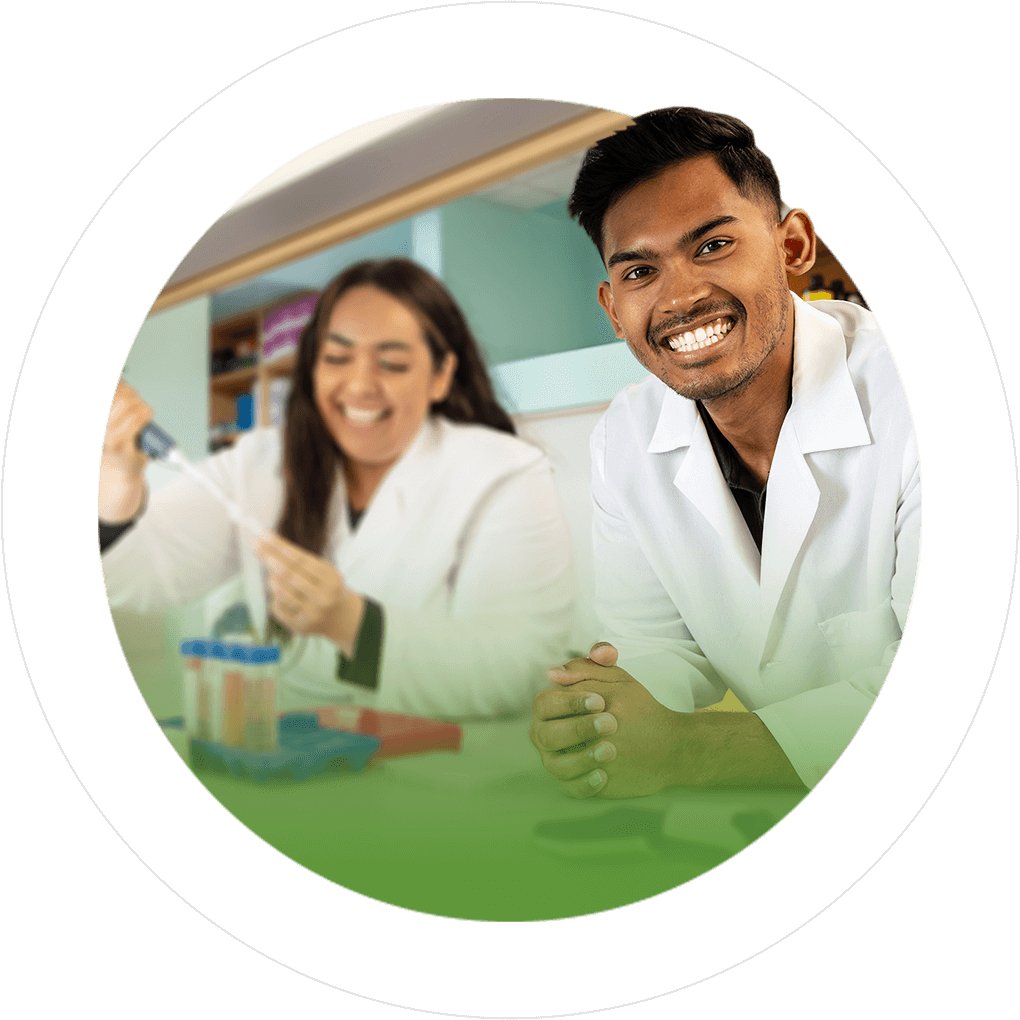Publications
Scholarly Journals--Published
- Uppala PT, Dissmore T, Benjamin Lau BH, Andacht T, Rajaram S. (2013) Selective inhibition of cell proliferation by lycopene in MCF-7 breast cancer cells in Vitro: a proteomic analysis. Phytotherapy Research (4): 595-601 Lycopene, a red pigmented carotenoid present in many fruits and vegetables such as tomatoes, has been associated with the reduced risk of breast cancer. This study sought to identify proteins modulated by lycopene during cell proliferation of the breast cancer cell line MCF-7 to gain an understanding into its mechanism of action. MCF-7 breast cancer cells and MCF-10 normal breast cells were treated with 0, 2, 4, 6, 8, and 10 μM of lycopene for 72 h. 3-(4,5-Dimethylthiazol-2-yl)-2,5-diphenyltetrazolium bromide (MTT) tetrazolium reduction assay was used to measure cell proliferation and two-dimensional fluorescence difference gel electrophoresis to assess the changes in protein expression, which were identified using MALDI-ToF/ToF (matrix-assisted laser desorption ionization tandem time-of-flight) and Mascot database search. MTT and cell proliferation assays showed that lycopene selectively inhibited the growth of MCF-7 but not MCF-10 cells. Difference gel electrophoresis analysis revealed that proteins in the MCF-7 cells respond differently to lycopene compared with the MCF-10 cells. Lycopene altered the expression levels of proteins such as Cytokeratin 8/18 (CK8/18), CK19 and their post translational status. We have shown that lycopene inhibits cell proliferation in MCF-7 human breast cancer cells but not in the MCF-10 mammary epithelial cells. Lycopene was shown to modulate cell cycle proteins such as beta tubulin, CK8/18, CK19 and heat shock proteins. Copyright © 2012 John Wiley & Sons, Ltd. (06/2013) (link)
- Padma T Uppala, Shambu K Roy, Albert Tousson, Stephen Barnes, Gurunatha Uppala and David A Eastmond. "Induction of cell proliferation and hyperdiploidy/polyploidy in the mammary cells of DDT-and DMBA-treated pubertal rats." Environmental and Molecular Mutagenesis 46.1 (2005): 43-52. The environmental estrogen, dichlorodiphenyltrichloroethane (DDT), and its metabolites have been implicated in the development of breast cancer through mechanisms that remain to be elucidated. It has been hypothesized that exposure to DDT and its metabolites, during critical periods of development, can contribute to an elevated risk for breast cancer in adults. In the present study, we have investigated the effect of o,p'-DDT on mammary gland cell proliferation and chromosomal alterations, in a rat mammary cancer model (commonly used to study human cancer), to gain insights into its potential role in the development of breast cancer. Twenty-one-day-old female Sprague-Dawley (SD) rats were administered o,p'-DDT, 7,12-dimethylbenz[a]anthracene (DMBA), genistein, DDT+DMBA, or DDT+DMBA+genistein, over a 14-day period. To determine changes in chromosome number and structure, we used the micronucleus assay as well as multicolor fluorescence in situ hybridization (FISH) region-specific DNA probes for rat chromosomes 4 and 19. Cell proliferation was evaluated using 5-bromo-2'-deoxyuridine (BrdU). Significant increases in BrdU-incorporated cells were seen in the rats treated with DDT+DMBA. Although micronucleus frequencies were somewhat elevated in several of the treatment groups, significant increases were not seen in any of them. Significant increases in numerical chromosomal aberrations were detected in all of the DDT- and DMBA-treated groups. Genistein significantly reduced BrdU incorporation and polyploidy in the DDT+DMBA-treated rats. These initial studies indicate that DDT and DMBA can induce cellular and chromosomal alterations in the rat mammary gland, which is consistent with the hypothesis that these agents can induce early events in mammary carcinogenesis. (c) 2005 Wiley-Liss, Inc. (07/2005) (link)
- Balakrishna S, Tadi-Uppala PP, Hasegawa L, Rupa DS and Eastmond DA. "Detection of micronuclei, cell proliferation and hyperdiploidy in bladder epithelial cells of rats treated with 0o-phenylphenol." Mutagenesis 17.1 (2002): 89-91. o-Phenylphenol (OPP), a widely used fungicide and antibacterial agent, has been considered to be among the top 10 home and garden pesticides used in the USA. Earlier studies have consistently shown that the sodium salt of OPP (SOPP) causes bladder cancer in male Fischer 344 (F344) rats, whereas OPP has produced variable results. This difference has been attributed to the presence of the sodium salt. To determine cellular and genetic alterations in the rat bladder and the influence of the sodium salt, F344 rats were administered 2% OPP, 2% NaCl and 2% NaCl + 2% OPP in their diet for 14 days. Twenty-four hours before being killed the animals were administered 5-bromo-2'-deoxyuridine (BrdU) by i.p. injection. Bladder cells were isolated, stained with DAPI and scored for the presence of micronuclei and incorporation of BrdU into replicating cells. To determine changes in chromosome number, we used fluorescence in situ hybridization (FISH) with a DNA probe for rat chromosome 4. Significant increases in the frequency of micronuclei and BrdU incorporation were seen in bladder cells of rats from all treatment groups. In contrast, the frequency of hyperdiploidy/polyploidy in treated animals was not increased over that seen in controls. A high control frequency of cells with three or more hybridization signals was seen, probably due to the presence of polyploid cells in the bladder. The presence of polyploid cells combined with cytotoxicity and compensatory cell proliferation makes it difficult to determine whether OPP is capable of inducing aneuploidy in the rat urothelium. In summary, these studies show that OPP can cause cellular and chromosomal alterations in rat bladder cells in the absence of the sodium salt. These results also indicate that at high concentrations the sodium salt can enhance chromosomal damage in the rat urothelium. (01/2002) (link)
- Balakrishna S, Hasegawa L, Rupa DS, Tadi Uppala P, Eastmond DA. "Detection of hyperdiploidy in bladder epithelial cells of rats treated with ortho-phenylphenol using fluorescence in situ hybridization." Environmental and Molecular Mutagenesis 33. (1999): 13-. (01/1999)
- Wong BYY, Lau BH, Tadi PP, and Teel RW. "Chinese medicinal herbs inhibit aflatoxin B1 and Benzo(a)pyrene induced mutagenesis." Mutation Research 279. (1992): 209-216. Oldenlandia diffusa (OD) and Scutellaria barbata (SB) have been used in traditional Chinese medicine for treating liver, lung and rectal tumors while Astragalus membranaceus (AM) and Ligustrum lucidum (LL) are often used as an adjunct in cancer therapy. In this study, we determined the effects of aqueous extracts of these four herbs on aflatoxin B1 (AFB1)-induced mutagenesis using Salmonella typhimurium TA100 as the bacterial tester strain and rat liver 9000 x g supernatant as the activation system. The effects of these herbs on [3H]AFB1 binding to calf-thymus DNA were assessed. Organosoluble and water-soluble metabolites of AFB1 were extracted and analyzed by high-performance liquid chromatography (HPLC). Mutagenesis assays revealed that all of these herbs produced a concentration-dependent inhibition of histidine-independent revertant (His+) colonies induced by AFB1. At a concentration of 1.5 mg/plate, SB and OD in combination exhibited an additive effect. The trend of inhibition of these four herbs on AFB1-induced mutagenesis was: SB greater than LL greater than AM. LL, OD and SB significantly inhibited AFB1 binding to DNA, reduced AFB1-DNA adduct formation, and also significantly decreased the formation of organosoluble metabolites of AFB1. Our data suggest that these Chinese medicinal herbs possess cancer chemopreventive properties. (01/1992) (link)
- Tadi PP, Teel RW and Lau BHS. "Organosulfur compounds of garlic modulate mutagenesis, metabolism and DNA Binding of aflatoxin B1." Nutrition and Cancer 15. (1991): 87-95. The effects of two organosulfur compounds of garlic (ajoene and diallyl sulfide) and a crude garlic extract on aflatoxin B1 (AFB1)-induced mutagenesis were determined using rat liver 9,000 g supernatant (S-9) as the activation system and Salmonella typhimurium TA-100 as the tester strain. The effects of these compounds on AFB1 binding to calf thymus DNA were also measured. Metabolites of AFB1 were isolated and analyzed by reverse-phase high-performance liquid chromatography. All these compounds inhibited S-9-dependent mutagenesis induced by AFB1. They also inhibited AFB1 binding to DNA. A significant decrease in organo-soluble metabolites of AFB1 was observed with ajoene and garlic extract. An increase of glucuronide and glutathione conjugates was obtained with garlic extract. The results indicate that garlic compounds tested in this study are antimutagenic and, potentially, anticarcinogenic. (01/1991) (link)
- Tadi PP, Teel RW and Lau BHS. "AFB1 binding to DNA inhibited by ajoene and Dially sulfide." Anticancer Research 11. (1991): 2037-2042. Components of garlic have been shown to inhibit a variety of tumors induced by chemical carcinogens. In this study we determined the effects of ajoene and diallyl sulfide (DAS), two organosulfur compounds of garlic, on the metabolism and DNA binding of aflatoxin B1 (AFB1) using rat liver 9000Xg supernatant as the metabolic activation system. Organosoluble and water-soluble metabolites of [3H]AFB1 were isolated by reverse-phase high performance liquid chromatography (HPLC). The effects of ajoene and DAS on glutathione-S-transferase (GST) were determined using 1-chloro-2,4-dinitrobenzene as the substrate. Ajoene and DAS at 100 mg/ml inhibited [3H]AFB1 binding to calf thymus DNA and adduct formation. They decreased the formation of both organosoluble and water-soluble metabolites of [3H]AFB1. Neither compound significantly affected GST activity. These results indicate that ajoene and DAS affected AFB1 metabolism and DNA binding by inhibiting phase I enzymes and may therefore be considered as potential cancer chemopreventive agents. (01/1991) (link)
- Lau BHS, Tadi PP, and Tosk JM. "Allium sativum (garlic) and cancer prevention." Nutrition Research 10. (1990): 937-948. (01/1990)
- Tadi PP, Teel RW, and Lau BHS.. "Anticandidal and anticarcinogenenic potentials of garlic.." International Clinical Nutrition Review 10. (1990): 423-429. (01/1990)
Abstract
- (NON-PEER REVIEWED) National Institute of Health. Center for Health Disparities Research P20 grant. $6 million from 6-1- 2012-2017 The grant was awarded to Loma Linda University to establish a health disparities research center. The title of the project in which I serve as a co-investigator is “Mechanisms in IGF-II induced chemoresistance and mitochondrial regulation in TNBC” (10/2012 - 10/2016)
- (PEER REVIEWED) Uppala P, Kolli KVS, Kirchner D, Blackledge W, Beeson L, Thadi P, Garberoglio C, Preuss A, Morgan J, Uppala G, Lum S, Mural R and Liebman M.. "Protein profiling to identify serum biomarkers for early detection of breast cancer in African American women." Proceedings, American Association for Cancer Research . (2006): -. (04/2006)
Books and Chapters
- Patterson, L., Tadi Uppala P., Pilla, Ep., (2011) Evidence of Modern Science in the Bible (Book), Wake Up India, Bangalore, India Many Christians believe that the creation of the earth in six days as stated in the Bible is not literal, and suggest that each day represents millions of years. The idea of creation occurring over millions of years came from the belief that the fossil record of evolution was built up over many millennia. However, the Bible clearly states that the earth was created in six days out of nothing. God spoke and the earth was created. God is not limited by natural processes and time. God communicates to his people through the Bible and nature. Let us then, explore these two sources of God’s word to understand the biblical creation. We will use both the book of Genesis and Exodus from the Bible1 and the periodic table of the chemistry from the natural sciences to enlighten this truth. An amazing concept discovered by Peterson, L. (2008)3, about the Genesis creation story, parallels the periodic table of chemistry, which testifies that the earth could have been created in six literal days. A careful search of the literature did not yield any studies pertaining to creation and the periodic table. Therefore, the idea put forth in this Book is the original concept. Careful scrutiny of the periodic table, the basic foundation of the science of chemistry, reveals that the organization and classification of the elements in the periodic table reflect the sequence of elements used in the creation during days one through six. The periodic table is a listing of all the known 118 elements in the universe arranged into groups and periods according to similar characteristics and reactivity. Elements of the periodic table such as gold, copper, tin, lead, silica, carbon, hydrogen, nitrogen, oxygen, etc., combine with one another to form many compounds that form the building blocks of our universe4. The periodic table is the most important reference in chemistry; it is the Bible of chemistry. It appears that critical elements or compounds needed for the work on each day of creation were created on that day or during the days prior. It was discovered by Patterson that the elements needed during the six days of creation appear sequentially in the seven periods of the periodic table. Another amazing discovery by Paterson is the similarity in the construction and organization of the periodic table and the biblical sanctuary, which is central to Christianity. In the article below, we will first describe the mysterious and amazing organization of the periodic table and demonstrate how it parallels both the creation and the sanctuary. (03/2011)
- 2009 Community Profile Inland Empire Affiliate report, Parker, K., Villa, T., Tadi-Uppala, P., Beeson L., Morgan, J., Waife, S., Mathur, A., Aurora, A., Erande, A., Shittu, Ak. (08/2009)
- Inland Empire Education Curiculum for breast cancer (2009). Tadi-Uppala, Mathur, A., Erande, A, Adesanya, D., Forbes, R.. (08/2009)
Book Review - Scholarly Journals--Published
- Padma P. Tadi-Uppala, Ashwini S. Erande, Jilliane Cabansag, Larry Beeson, Naomi Modeste, Susanne Montgomery, Morgan John. “Barriers to participation in breast cancer clinical trials for Black women in the Inland Empire, CA” [Abstract]. The science of Cancer Health Disparities Proceedings (2009). (08/2009)
- Tadi-Uppala, P et al. Biomarkers for breast cancer in African American women [Abstract]. American Association for Cancer Research Annual Meeting Proceedings (2007). (08/2007)
- 1. Padma Tadi-Uppala, Community based risk assessment: DDT contamination in Triana Alabama, Risk Assessment for Environmental Health (Robson MG and Toscano, WA Editors) San Francisco, CA, John Wiley and Sons 2007 (08/2007)
- Michelle A. Hoag, Corwin Porter, Padma P. Uppala and David Dyjack. A Risk-based Food Inspection Program. Journal of Environmental Health, 200610 Al. 2007 (08/2007)











